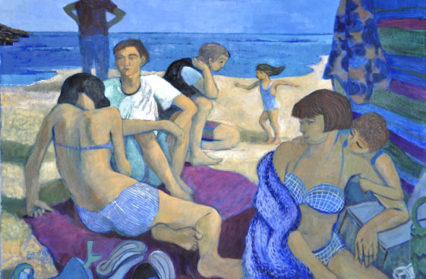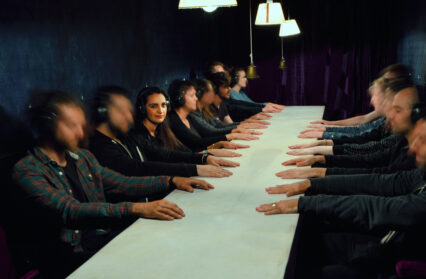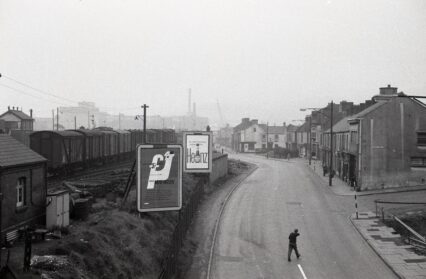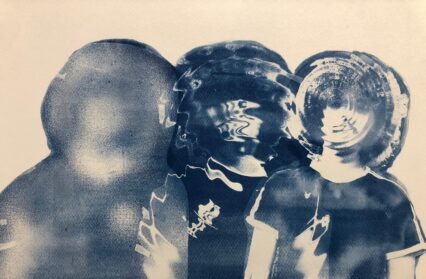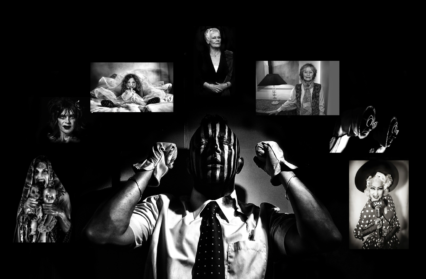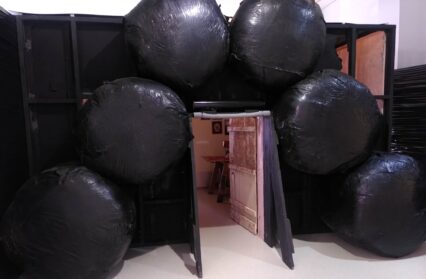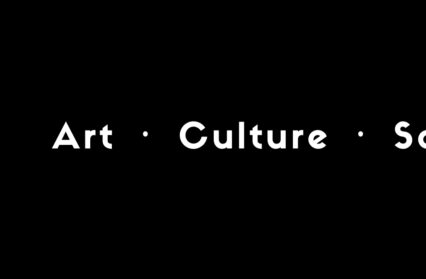The Martin Tinney Gallery in Cardiff is celebrating its first 25 years with a pair of exhibitions in April and May 2017 which showcase some of the outstanding modern and contemporary art of Wales. Peter Wakelin explores the gallery’s significance in helping to expand the possibilities for Welsh visual art.
Visual art cannot thrive in a country unless there are galleries to support it. Seventy years ago the painter Sir Cedric Morris recognised that this was a grave problem for Welsh art. He wrote in a letter in 1947:
I am afraid my view of the future of art in Wales is this – there is no future as long as the Welsh people are not interested in it – condemn their painters to unemployment, as far as painting is concerned. It would be interesting to find out exactly how many paintings done by serious artists are bought annually in Wales – less than half a dozen I expect… And those that are bought, if any, would probably not be painted by Welshmen – or bought by Welshmen… There is not even an art critic in the country – let alone a gallery where any could hold a private exhibition!!!
Much has changed in the two generations since those words were written. Twenty-five years ago, Martin Tinney decided to try to address just the issues Morris railed at. He sought to deal in the best of modern and contemporary Welsh art, to appeal to collectors who had purchased mainly beyond the border and to draw in a new audience to discover what Welsh art had to offer.
Wales was lucky in its public galleries by the time when Cedric Morris was writing – Swansea had the Glynn Vivian, there were the National Museum in Cardiff and Turner House in Penarth; Llandudno had the Mostyn from 1901, and the National Library in Aberystwyth included art in its brief. But for artists to make a living requires commercial galleries not just public ones, and none existed in the first half of the twentieth century. Artists’ societies of one kind or another offered the best chances to make sales, for example the Royal Cambrian Academy, founded as long ago as 1882, the South Wales Group (later the Welsh Group), begun in 1948, and the 56 Group and the Watercolour Society of Wales, both established in the 1950s.
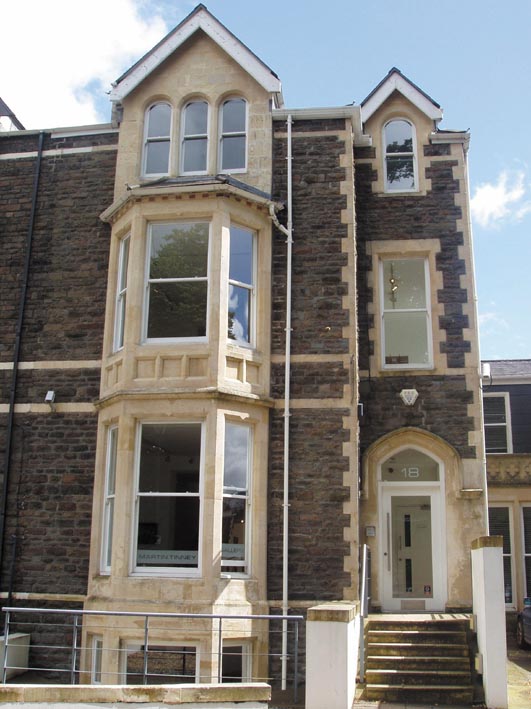 Probably no commercial gallery existed in Wales before 1953, when one opened with the self-explanatory name, the ‘Cardiff Gallery’. It closed within a year but it was followed in 1956 by the Howard Roberts Gallery, which for the first time began to attune a substantial public in Wales to buying art. For some fourteen years it showed the established and younger Welsh painters of the time, including Roger Cecil, John Elwyn, Ray Howard-Jones, Augustus John, Tom Rathmell, Ceri Richards and Kyffin Williams. But it was not exclusively a gallery representing Welsh art, indeed its relationship with Marlborough Fine Art in London enabled it to show renowned British painters and sculptors such as Prunella Clough, Barbara Hepworth, Henry Moore, Ben Nicholson and John Piper.
Probably no commercial gallery existed in Wales before 1953, when one opened with the self-explanatory name, the ‘Cardiff Gallery’. It closed within a year but it was followed in 1956 by the Howard Roberts Gallery, which for the first time began to attune a substantial public in Wales to buying art. For some fourteen years it showed the established and younger Welsh painters of the time, including Roger Cecil, John Elwyn, Ray Howard-Jones, Augustus John, Tom Rathmell, Ceri Richards and Kyffin Williams. But it was not exclusively a gallery representing Welsh art, indeed its relationship with Marlborough Fine Art in London enabled it to show renowned British painters and sculptors such as Prunella Clough, Barbara Hepworth, Henry Moore, Ben Nicholson and John Piper.
Once Howard Roberts had shown what could be achieved, other galleries opened, some of which continue to this day – the Attic Gallery in Swansea in 1962, Oriel Tegfryn at Menai Bridge in 1963, the Albany at Roath in 1965. Nevertheless, the Martin Tinney Gallery, when it arrived in 1992, did four things that previous commercial galleries had not: first, it specialised wholly in Welsh art, second, it regularly stocked historical works as well as contemporary ones and showed them alongside one another, third, it took art from Wales into international markets, and finally, over time, it invested with unprecedented confidence.
Given the truism that incomers often make the biggest difference to places, it might not be surprising that an Irish doctor should create a gallery of Welsh art. Visual art was a passion for Martin Tinney when he was growing up in Ireland – he started acquiring pictures in a small way when he was in his late teens. On leaving school he was torn between studying art history and medicine at university. Medicine won out: he qualified in Ireland and worked in Scotland, England, Wales and latterly as the medical director of a clinical research company in Ireland. But after a few years he began to think about an alternative career with art and he came to live in Cardiff, where his partner Nick Yarr was a GP.
He was disappointed to discover in Cardiff that no galleries showed the range and quality of work he would have expected in a capital city. Like so many collectors before him, he found himself going to London to acquire art, but unlike them he began to think about how to do address the problem. For eighteen months he helped with and eventually managed the exhibition space on the top floor of Jacobs antiques market at West Wharf. At the same time, he set about some serious research into gallery practice across Britain, seeking to avoid the traps that cause so many galleries (like the Cardiff Gallery of 1953) to close within a year or two. He wanted to add to his appreciation of art a knowledge of the kinds of good practice that so many aspiring gallerists fail to think about: mundane but crucial matters such as stock control, insurance, conditions of sale, publicity and mailing lists.
In 1992, he found premises on two floors above a copy shop in Windsor Place. He took the space in February and was ready to open in April with a first show by Harry Holland. He says that he knew he would make it work, if only through his optimism and stubbornness. However, the recession of the early nineties made it a great deal harder. For the first five years Martin took no salary but worked seven days a week – six in the gallery and one visiting artists’ studios.
His vision from the start was to create an authoritative home for the modern and contemporary art of Wales and since then he has always focused on artists with strong Welsh connections: one of his models was the Scottish Gallery in Edinburgh with its equivalent remit as the gallery for the modern and contemporary art of Scotland. He soon became known by customers as someone with genuine knowledge and judgement in the field.
In order for a gallery to be authoritative it needs not only to show stock from contemporary artists but to buy and sell important works from the past. Even Howard Roberts had not taken this step, but for Martin it was fundamental. He believed that the substance of the best contemporary art was clarified by an association with historical pieces, so, for example, he acquired early paintings by John Elwyn to show alongside the artist’s latest works; he put on a series of outstanding exhibitions of Ceri Richards; visitors might find watercolours from the 1950s by John Piper alongside infinitely more affordable ones straight from the studio of Mary Lloyd Jones.
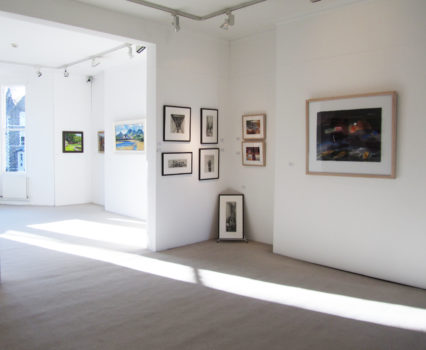 Martin also began straight away to take Welsh art to wider markets. He wanted to pit it against the best international art by showcasing it in London. It was gruelling work and costly, but in the next two decades he attended over sixty art fairs, drawing in new customers and raising awareness among people from all over the world of the quality of art from Wales. Solo art-fair shows helped to establish artists such as Shani Rhys James, Mary Griffiths and Sally Moore. He went beyond London too, sending an exhibition of Important Welsh Artists to San Francisco in 1993, and subsequently showing in Belgium.
Martin also began straight away to take Welsh art to wider markets. He wanted to pit it against the best international art by showcasing it in London. It was gruelling work and costly, but in the next two decades he attended over sixty art fairs, drawing in new customers and raising awareness among people from all over the world of the quality of art from Wales. Solo art-fair shows helped to establish artists such as Shani Rhys James, Mary Griffiths and Sally Moore. He went beyond London too, sending an exhibition of Important Welsh Artists to San Francisco in 1993, and subsequently showing in Belgium.
At Windsor Place Martin’s office was in the gallery space itself so, whatever subtle negotiation or detailed paperwork he might be concentrating on, there was no escaping the talkative visitors, the hopeful artists wanting him to look at their work, the people asking about some picture that they had found in the attic. His patience was sometimes tested, especially by would-be artists who presumed he would give them his time without an appointment. Luckily, he could eventually employ staff with the patience of saints.
In 2002, he took his confidence in Welsh art to a new level by remortgaging his house to purchase and remodel a building in St Andrew’s Crescent and create a superb new gallery. The result was a space on three floors that many a dealer in Mayfair might covet, fit equally for museum-quality pictures and domestic works. It can host up to three principal exhibitions simultaneously, and a viewing room and store enable him to offer customers a wide choice of reserve stock. Collectors newly visiting Cardiff are often amazed that Wales can produce such quality.
Conjoined to these facilities since 2010 has been the long-established Oriel Tegfryn in Menai Bridge, which Martin acquired and refurbished, bringing together its stable of artists such as Keith Andrew, Keith Bowen, Karel Lek, Wilf Roberts and William Selwyn with that of the Cardiff gallery, and taking Martin Tinney Gallery exhibitions to audiences in North Wales.
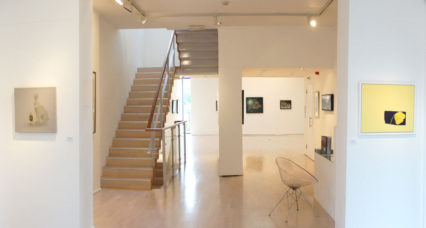 The gallery established its quality from the beginning. When Wales sometimes seems to be dominated, despite its increasing number of serious galleries, by frame-shops or gift-shops with a few pictures tagged on, or artist’s studios with an open door, or shops targeting pictures at passing tourists, the Martin Tinney Gallery is a different phenomenon altogether – beautiful spaces, professional presentation, and a depth and quality of artists.
The gallery established its quality from the beginning. When Wales sometimes seems to be dominated, despite its increasing number of serious galleries, by frame-shops or gift-shops with a few pictures tagged on, or artist’s studios with an open door, or shops targeting pictures at passing tourists, the Martin Tinney Gallery is a different phenomenon altogether – beautiful spaces, professional presentation, and a depth and quality of artists.
Over the years, the gallery has helped a fairly conservative Cardiff market to embrace a wider range of work. (For a long time, for example, it was difficult to sell abstract art, but that has begun to change.) Martin has stuck with artists he rated even if their work sold infrequently: he says that though inevitably some artists have drifted away he has never asked one to leave. Loyalty in his relationships has been important to him; most artists have become friends and are well represented in his and Nick’s own collection.
Many have stayed with him for the best part of the twenty-five years, like Dick Chappell, Clive Hicks-Jenkins, Harry Holland, Shani Rhys James, Mary Lloyd Jones, John Macfarlane, Sally Moore, Sigrid Muller, Kevin Sinnott, Vivienne Williams and William Wilkins. They see Martin as professional, reliable and absolutely honest. They also may find him occasionally forbidding, but art can be a rackety business so even this is a positive quality for those who may have experienced dealers more characterised by ineptitude, false praise, disorganisation or financial irresponsibility. New artists continue to join the gallery, but necessarily a tiny number compared with the three or four a day who enquire about representation.
The twenty-fifth anniversary exhibitions restate the quality and importance of Welsh art. The earlier of the two includes the great painters of twentieth-century Wales. It begins with the artists who were becoming famous in the early years of the century – Augustus John, his younger friend J. D. Innes whose outpouring of vigorous landscapes was to make his name even after his death aged only 27 in 1914, and Gwen John, shown here in all her Intimiste softness by a painting of a sitting girl from around 1920 and a delicate pencil portrait of her brother’s greatest muse, Dorelia. From just a few years later comes a landscape by David Jones: it is rare for a full-bodied painting to come onto the market and this one delicately expresses a sense of safety among feathery trees and fronds.
Stars from mid-century include the Surrealist Three Figures in a Landscape by Merlyn Evans, who is most associated with Scottish art but was born in Cardiff to a Welsh family, and Girl at the Piano by the brilliant Ceri Richards, here seen at the height of his infatuation with Matisse and Picasso, somehow seeming to paint the music that will spill into the room. Plantsman-painter Cedric Morris, who had so much influence on Welsh art through his teaching as well as his furious campaigning, is represented by an efflorescence of poppies, artichokes, geraniums and lilies. There is a calmly tonal Snowdonia mountain scene by the most popular of twentieth-century Welsh landscape painters, Kyffin Williams.
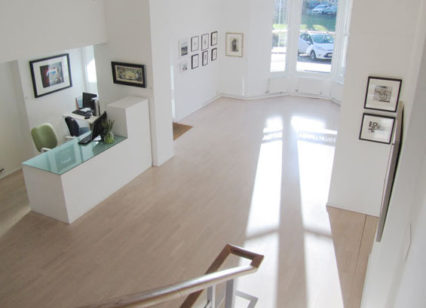 The historical exhibition may look back to the beginning of the twentieth century but it also necessarily encompasses the twenty-five years of history that the gallery has helped to make. Several artists who have shown with Martin Tinney are no longer with us. The Road to Gower by John Elwyn, who died in 1997, must be among his most beautiful paintings, vibrant with rich greens that few other artists can handle and dancing to the strange geometry of trees and shadows that he made his own. As in so many of his landscapes, Elwyn makes one wish that one could walk inside the picture, to explore those whitewashed barns on the way down to the sea. Ernest Zobole had many successful exhibitions at the gallery: a scintillating painting of a dog on an armchair shows him experimenting with form and colour in the 1960s. The unexpected death of Peter Prendergast in 2007 was a sad loss to Welsh art, but his work continues to be appreciated: his view of the slate-quarry village of Deiniolen, the spike of the church spire at the centre, extraordinarily expresses the muscular structures and harmonious colours of the landscape where he made his home. Another of the great Welsh artists who showed with the gallery, Evelyn Williams, who died in 2012, is sure to be appreciated more and more in coming years.
The historical exhibition may look back to the beginning of the twentieth century but it also necessarily encompasses the twenty-five years of history that the gallery has helped to make. Several artists who have shown with Martin Tinney are no longer with us. The Road to Gower by John Elwyn, who died in 1997, must be among his most beautiful paintings, vibrant with rich greens that few other artists can handle and dancing to the strange geometry of trees and shadows that he made his own. As in so many of his landscapes, Elwyn makes one wish that one could walk inside the picture, to explore those whitewashed barns on the way down to the sea. Ernest Zobole had many successful exhibitions at the gallery: a scintillating painting of a dog on an armchair shows him experimenting with form and colour in the 1960s. The unexpected death of Peter Prendergast in 2007 was a sad loss to Welsh art, but his work continues to be appreciated: his view of the slate-quarry village of Deiniolen, the spike of the church spire at the centre, extraordinarily expresses the muscular structures and harmonious colours of the landscape where he made his home. Another of the great Welsh artists who showed with the gallery, Evelyn Williams, who died in 2012, is sure to be appreciated more and more in coming years.
The second exhibition includes all the artists represented by the gallery now – some fifty in all and a remarkable pool of talent. It ranges from younger artists like Meirion Ginsberg (born 1985) to established figures such as Charles Burton (born 1929). In terms of media, the greatest focus is on painting and printmaking but also among current artists are the textile artist Eleri Mills and the doyenne of collage Rosemary Burton. In a country as beautiful and diverse as Wales it is not surprising that landscape predominates, whether remote and delicately patterned by nature as in the work of Sarah Thwaites or man-made and desolate (Iwan Gwyn Parry). But this is far from being an exclusive theme and the gallery is particularly strong too in figure painting – the concentrated self-portraits of Shani Rhys James and Sally Moore, the figure groups of Claudia Williams and the stage and costume designs of John Macfarlane.
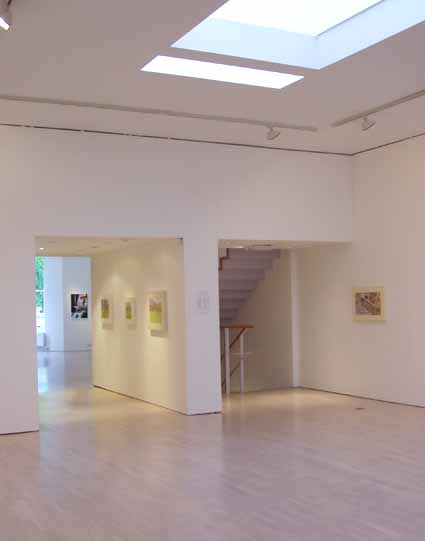 Where will galleries in Wales be in another twenty-five years’ time? New galleries have opened since the Martin Tinney Gallery, enriching the ecosystem. But others are closing under the pressure of retail decline and business rates or are abandoning physical premises to sell on-line. Some individual artists now prefer to market themselves on Instagram or Etsy, which sadly undermines the viability of the very entities that make artistic reputations. To lose galleries where one can discover Welsh art in context and see the physical, material things that sculptures, paintings and drawings are would be a huge loss. Aspects of contemporary art practice pose challenges too. Video, installation and objects made from unstable materials draw the media coverage and curatorial attention but the number of collectors following such works is small; only a few galleries in capital cities make headway in this refined international specialism.
Where will galleries in Wales be in another twenty-five years’ time? New galleries have opened since the Martin Tinney Gallery, enriching the ecosystem. But others are closing under the pressure of retail decline and business rates or are abandoning physical premises to sell on-line. Some individual artists now prefer to market themselves on Instagram or Etsy, which sadly undermines the viability of the very entities that make artistic reputations. To lose galleries where one can discover Welsh art in context and see the physical, material things that sculptures, paintings and drawings are would be a huge loss. Aspects of contemporary art practice pose challenges too. Video, installation and objects made from unstable materials draw the media coverage and curatorial attention but the number of collectors following such works is small; only a few galleries in capital cities make headway in this refined international specialism.
Despite such challenges, the Martin Tinney Gallery’s leading position in the market keeps it strong. There remains an important job to be done to increase appreciation of the achievements of Welsh art. Our artists are still not fully recognised, still not as highly sought-after as their Scottish, English and Irish equivalents, who have won higher profiles in national consciousness and international markets. While some of the best-known names of Irish and Scottish art achieve six-figure sums, and the major auction houses put on successive specialist sales to cater for them, modern and contemporary Welsh art is yet to be lauded in the same ways.
So there is still a battle to be joined to give Welsh art the recognition it deserves. More might be expected from our public galleries particularly – the Welsh Government’s renewed commitment to seeking new facilities for the modern and contemporary art of Wales may prove significant. But the twenty-five years of the Martin Tinney Gallery have proved without doubt that there is a future for art in Wales. The risks that Martin Tinney has taken to make a market have paid off for the rest of us.
How do you measure such a gallery’s impact? It has sold over 12,000 Welsh works of art. It has helped to make the careers of dozens of Welsh artists through nearly 300 exhibitions since 1992. But even more persuasive than figures is the anectodal evidence, for example of the exhibitions that, like John Knapp-Fisher’s, have opened to queues around St Andrew’s Crescent, or the three or four hundred people who turned up excitedly to the opening of the new gallery in 2002. But perhaps the most telling of all illustrations is that the artist couple Claudia Williams and Gwilym Prichard came back from France to Wales because, for the first time in their careers, they saw that they could make a living selling pictures here.
The Martin Tinney Gallery has supported art practice and attuned a widespread public to the idea of Welsh art. Cedric Morris would be very pleased.
Click HERE to see our celebration of 25 years of the Martin Tinney Gallery with an exclusive display of some of the great works associated with the gallery over the years. (All images recreated with kind permission of the gallery).


